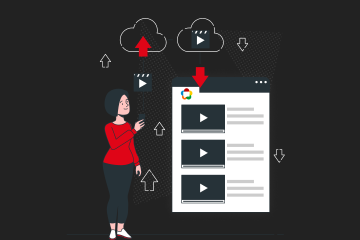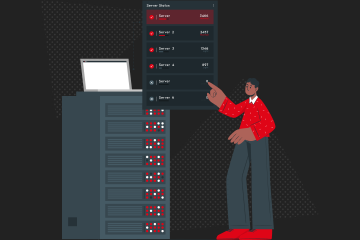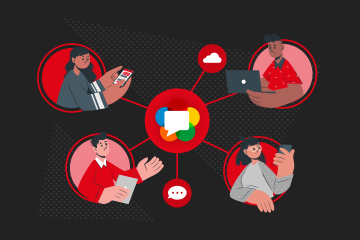WebRTC has been a very important protocol since its release, however, its importance has increased with the Pandemic. WebRTC has become one of the most important standards for developing applications that need real-time latency, as it can be integrated into any browser without the need for standalone application downloads. It is supported by all major web browsers. WebRTC mobile apps meet real-time communication needs.
This technology allows direct and seamless communication from almost any endpoint such as phones, web pages, cars, and even home appliances. Its simplicity and ubiquitous potential makes it an excellent video and audio streaming solution, especially in video conferencing, audio only, and peer-to-peer networking.
In this article, I will tell you everything you need to know about WebRTC mobile application development.
What we will cover,
- General information about WebRTC
- WebRTC mobile app and web service examples
- Native WebRTC mobile app development with Android, iOS, and Flutter
- Common mistakes in building a WebRTC mobile app
What is WebRTC?

WebRTC stands for web real-time communications. It is a very exciting, powerful, and highly disruptive cutting-edge technology and a streaming protocol.
WebRTC is HTML5 compatible and you can use it to add real-time media communications directly between browser and devices. One of the best part is that you can do this without the need for any prerequisite plugins to be installed in the browser. WebRTC is progressively becoming supported by all major modern browser vendors including Safari, Google Chrome, Firefox, Opera, and others.
Thanks to WebRTC, you can embed the real-time video directly into your applications to create an engaging and interactive streaming experience for your audience without worrying about latency.
How does WebRTC work?
- WebRTC sends data directly across browsers – it is called “P2P”.
- It can send audio, video, or data in real-time.
- It needs to use NAT traversal mechanisms for browsers to reach each other.
- P2P needs to be gone through a relay server (TURN).
- With WebRTC you need to think about signaling and media. They are different from each other.
- One of the main features of the tech is that it allows peer-to-peer (browser-to-browser) communication with little intervention from a server, which is usually used only for signaling.
- It’s possible to hold video calls with multiple participants using peer-to-peer communication. A media server helps reduce the number of streams a client needs to send, usually to one, and can even reduce the number of streams a client needs to receive.
- Servers you’ll need in a WebRTC product:
- Signaling server
- STUN/TURN servers
- Media servers (It is up to your use case)
Benefits of WebRTC for mobile apps

Google joined the video chat market with Gmail video chat in 2008. In 2011, Google introduced Hangouts and it was originally a feature of Google+, Hangouts became a stand-alone product in 2013. Google loved RTC technologies. It acquired GIPS, a company that develops many components required for RTC, such as codecs and echo cancellation techniques.
Google open-sourced the technologies developed by GIPS and engaged with relevant standards bodies at the Internet Engineering Task Force (IETF) and World Wide Web Consortium (W3C) to ensure industry consensus. In May 2011, Ericsson built the first implementation of WebRTC. Ericsson created the first implementation of WebRTC in May 2011. And this started the future of the communication industry.
Now, WebRTC is supported by almost all browsers such as Microsoft Edge, Google Chrome, Mozilla Firefox, Safari, Opera, BlackBerry, Vivaldi and PC, iOS, and Android.
Among the giant companies using WebRTC are Meta (Facebook, Messenger, WhatsApp), Amazon, and Google, as they have decided to make their web applications faster, reliable, and more secure.
So, is it worth developing a WebRTC mobile app? Here are some other benefits:
Device and platform independence
Supported by every operating system and browser, WebRTC can be implemented as an open web standard with simple JavaScript APIs. When developing a mobile application on Android and iOS, the common application flow is followed.
Integrating standard APIs from the W3C and a protocol from the Internet Engineering Task Force (IETF) enables initiating audio or video calls between WebRTC-based browsers and any other WebRTC device or media server.
Secure video and voice calling
Some usage areas need more security than others. For example, video conferencing applications have become an essential component of a secure business communication platform, messaging, and voice tools. That’s why it’s so important that WebRTC has permanent audio and video encryption.
Scalability
With the success of your application (I hope), the number of users will increase. An increasing number of users can negatively affect the user experience of your application. However, with WebRTC, you can scale the growing number of users and offer a unique experience.
Real-time engagement/Ultra-low latency
WebRTC mobile app and web service examples
WebRTC is used in hundreds of thousands of applications. Some of the most well-known
Google Meet
As you can guess, Google is one of the first to implement this technology. It created a much simpler and more useful product by replacing the plug-in obligatory technology it used before with WebRTC.
Facebook Messenger
The pioneer and first user of many technologies, Facebook, now known as Meta, was also under the spell of WebRTC. Facebook powered the messenger with WebRTC. It also integrated the video and voice calling feature of its other apps with WebRTC.
Discord
Discord, which is the favorite tool of the gamers and even the companies manage their communities on there, is one of the leading companies that trusts WebRTC. Discord implemented WebRTC to provide group voice calls and to support in-app messaging allowing users to add a supposedly unlimited number of people to calls.
Native WebRTC mobile app development
A WebRTC mobile application will usually go through a common application flow. Accessing the media devices, opening peer connections, discovering peers, and starting streaming.
Native mobile WebRTC application development is more complex than building a web-based service/application. Therefore, using ready-made SDKs will make your work much easier. Let’s first learn how to build a WebRTC mobile app for iOS.
How to build a WebRTC iOS App
Ant Media’s WebRTC iOS SDK lets you build your own iOS application that can publish and play WebRTC broadcasts with just a few lines of code.
In WebRTC iOS doc, we’re going to cover the following topics.
- Run the Sample WebRTC iOS app
- Publish Stream from your iPhone
- Play Stream on your iPhone
- P2P Communication with your iPhone
- Develop a WebRTC iOS app
- How to Publish
- How to Play
- How to use Data Channel
You can learn how to build a WebRTC iOS app here.
How to build a WebRTC Android App
You can use WebRTC facilities in the Android Platform with the help of Ant Media Server’s Native WebRTC Android SDK. In this WebRTC Android doc, features of WebRTC Android SDK will be presented with a sample Android project which comes bundled with the SDK.
WebRTC Android SDK has the following main features:
- Provides peer-to-peer WebRTC communication between Android devices and browsers by using Ant Media server as a signaling server.
- Could publish WebRTC stream which could be played by other Android devices and browsers (mobile or desktop).
- Could play WebRTC stream which is published by other Android devices and browsers (mobile or desktop).
- Could join conference room that is created in Ant Media Server.
You can learn how to build a WebRTC Android app here.
You can find more details about WebRTC SDKs here.
How to build a WebRTC App with Flutter
Ant Media’s Flutter WebRTC SDK helps you with building your Flutter application that can publish and play WebRTC broadcasts with just a few lines of code. It is very easy to use and integrate. Moreover, Ant Media does not charge extra for Flutter WebRTC SDK and other SDKs
In the detailed blog, we cover
- Prerequisite for Flutter development
- Software requirements
- How to set up your first application on Flutter
- Download and run the WebRTC sample projects
- Download the sample Flutter projects
- Configuration of the sample project
- Install dependencies and run sample project
- Run the sample WebRTC Flutter apps
- Running Publish Sample App
- Running Play Sample App
- Running Peer Sample App
- Running Conference Sample App
- Using WebRTC Flutter SDK
You can find the detailed blog post here.
Common mistakes in building a WebRTC mobile app
We have said that WebRTC is easy to use and implement, but there are still points to consider. To avoid them when building a WebRTC mobile app, pay special attention to the following:
Consider and test browser updates
WebRTC is still under development. That’s why you need to be aware of the latest updates and developments. Unfortunately, just following WebRTC is not enough. At the same time, you need to follow the updates of the browsers. It will be good for you to constantly test your application in different browsers.
Test your own mobile app updates
One of the most remarkable features of WebRTC is that it is supported by almost every platform. However, this means that you have to consider a lot more details during development. Your application running in one browser may fail in another browser, or your application running on iOS may run problematic on Android. That’s why you should test your app on as many platforms as possible after each update.
Test on multiple devices and networks
Different devices and networks can also cause problems. You cannot be sure on which devices and on what network your application will be used. That’s why you should run your tests on different devices and networks.
Ant Media’s SDKs for WebRTC Mobile apps
Ant Media Server is a real-time streaming software that offers ultra-low latency streaming with WebRTC technology. Any type of live stream can be delivered to a broad range of clients via highly automated, scalable, and clustered infrastructure on cloud or on-prem.
Ant Media Server provides remote management of the media server by using a robust Rest API set and is also provided with Android, iOS, Flutter, Unity, React Native, and JavaScript SDKs enabling live and ultra-low latency media access from any device. Btw, mobile SDKs are completely free.
Ant Media Server comes with adaptive bitrate control to manage live streams to be played at any network speed. Thanks to the rich features supported, users are also able to simulcast their video content to social media platforms such as Facebook, YouTube, and Twitter or any other platforms that support RTMP over the past four years, Ant Media has served a growing number of customers in segments like edtech, online video platforms, live auctioneers, radio and TV broadcasters, gaming, and mobile and web/app developers. Ant Media currently serves customers in over 120 countries and streams over 2 billion minutes a month.
FAQ about WebRTC mobile apps
Yes, you can use it to build mobile apps. Android and iOS support WebRTC.
Yes, WebRTC is supported by Android. WebRTC is developed with help of Google. It wouldn’t be a surprise to see Google is one of the first WebRTC users.
Yes, WebRTC works on iOS. You can build your own WebRTC iOS app with Ant Media’s WebRTC iOS SDK.
Here are some examples: Whatsapp, Facebook, Discord, Google Meet, Amazon Chime, and Snapchat.
All modern browsers support it.
Yes, all modern browsers support WebRTC on mobile.
Ant Media Server mobile SDKs are completely free. Some vendors in the sector charge over $300 per month for WebRTC SDKs. The fact that Ant Media Server SDKs are free is very beneficial for developers.







